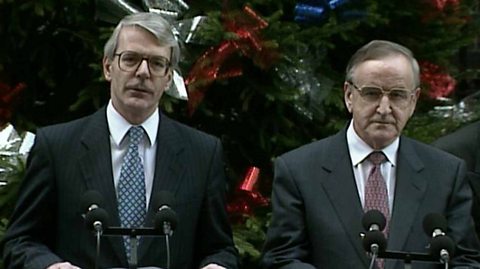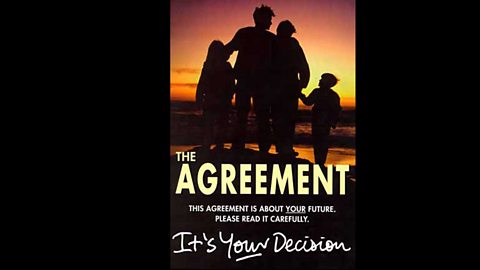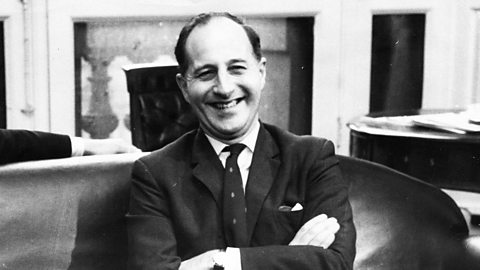Ulsterisation and criminalisation
For the rest of the 1970s and the early 1980s, successive British governments attempted, without success, to solve the Northern Ireland problem.
At the same time, although the levels of violence lessened due to improved security measures, the Provisional Irish Republican Army (PIRA)Irish republican paramilitary group formed when members split from the Official IRA (OIRA) in 1969. launched a campaign of violence in Britain, exploding bombs in towns and cities such as Guildford and Birmingham.
During these years, the WestminsterThe London location of the British government. government introduced policies designed to defeat the paramilitaryA person or organisation that operates like a military force, but is not part of a country's official armed forces. campaigns.
These new policies included:
- Ulsterisation: Increasing the size of the Ulster Defence Regiment (UDR)A regiment of the British Army established in 1970 in Northern Ireland and recruited locally. It was intended as a replacment for the the B specials reserve police force. and Royal Ulster Constabulary (RUC)Police force in Northern Ireland from 1922 to 2001., while reducing the numbers of British Army troops on the streets of Northern Ireland.
- Criminalisation: Ending special category statusThe recognition that those convicted of crimes connected with ‚Äėthe Troubles‚Äô had acted for political and not criminal reasons. for those convicted of terrorist crimes after March 1976. Anyone convicted after that date would be treated in the same way as other criminals. They would be sent to a new prison - consisting of H-shaped blocks - which had been built at the Maze outside Belfast.
The first hunger strike (1980)
Irish republicanA person who wants to establish an all Ireland republic completely independent of Britain. prisoners hated criminalisationPolicy introduced in the 1970s by the British government which targeted paramilitary groups. It ended special category status for those convicted of terrorist crimes after March 1976. Anyone convicted after that date would be treated in the same way as other criminals..
They believed themselves to be "freedom fighters" rather than criminals.
In order to oppose criminalisation they:
- Wore blankets rather than prison clothes This was known as the blanket protest.
- Then, in 1978, they started to smear their excrement on the walls of their cells rather than slop outThe emptying by prisoners of their buckets of excrement when their cells are unlocked each morning. This was known as the dirty protest.
Neither action resulted in the end of criminalisation, even though, by the end of 1980, nearly 40 per cent of republican prisoners were involved.
Nor did public protests or attacks on prison guards fare any better in terms of getting special category statusThe recognition that those convicted of crimes connected with ‚Äėthe Troubles‚Äô had acted for political and not criminal reasons. back.
On 27 October 1980, seven republican prisoners intensified the campaign against criminalisation by beginning a hunger strike.
After 52 days, the strike was ended as the prisoners wrongly believed that an agreement had been made with the government relating to the wearing of non-prison issue clothes.
The second hunger strike (1981)
On 1 March 1981, the Provisional Irish Republican Army (PIRA)Irish republican paramilitary group formed when members split from the Official IRA (OIRA) in 1969. prisoners’ officer commanding (OC), Bobby Sands, refused food.
Unlike the 1980 strike, this time only Sands began the strike; he was to be joined by a new hunger striker each week.
Sands believed that in this way the strike would lead to a prisoner dying each week, thus increasing the pressure on the British Government (now led by Margaret Thatcher) to end criminalisationPolicy introduced in the 1970s by the British government which targeted paramilitary groups. It ended special category status for those convicted of terrorist crimes after March 1976. Anyone convicted after that date would be treated in the same way as other criminals..
Although the hunger strike gained huge publicity, it did not change government policy.
Bobby Sands elected MP
On 5 March 1981, Frank Maguire, the MP for Fermanagh-South Tyrone, died.
As there was no law precluding prisoners becoming an MP, Irish republicanA person who wants to establish an all Ireland republic completely independent of Britain. saw their chance to increase pressure on the British and Bobby Sands was put forward as a republican candidate for the seat.
On the 40th day of his strike, Sands, standing as an Anti-H Block candidate, was elected to WestminsterThe London location of the British government..
His election campaign made news headlines across the world.
Even though Sands was now an MP, the British government remained determined not to give the prisoners what they were demanding, despite huge amounts of international pressure.
On 5 May, Sands died and over the next three and a half months, nine other prisoners lost their lives through hunger strike.
In the same five-month period, 61 people died as a result of the violence that broke out following each hunger striker’s death.
Throughout this time no concessions were granted.
Concessions granted
As time went on, without any concessions being granted, the families of those men still on hunger strike began to intervene to stop further deaths.
On 3 October 1981, the hunger strike was called off.
Within a few days of the strike’s end, the British government announced that:
- Prisoners could wear their own clothes.
- More prison visits would be allowed.
- Prisoners would be allowed to spend more time together during the day.
- It would reinstate the 50 per cent reduction in length of sentence. This concession had been lost by those prisoners involved in the protests against criminalisationPolicy introduced in the 1970s by the British government which targeted paramilitary groups. It ended special category status for those convicted of terrorist crimes after March 1976. Anyone convicted after that date would be treated in the same way as other criminals..
These concessions resulted in the protests in favour of special category statusThe recognition that those convicted of crimes connected with ‚Äėthe Troubles‚Äô had acted for political and not criminal reasons. all but ending by late October 1981.
Impact of the hunger strike
The 1981 Hunger Strike had a number of important consequences:
- A greater level of nationalistPeople who believe their country should be independent from other nations. For example, Irish nationalists, who want Ireland to be fully independent of Britain. hostility towards the British Government.
- An increase in support for the Provisional Irish Republican Army (PIRA)Irish republican paramilitary group formed when members split from the Official IRA (OIRA) in 1969..
- An increase in the levels of paramilitaryA person or organisation that operates like a military force, but is not part of a country's official armed forces. violence.
As a result, Thatcher’s government was coming under pressure from:
- unionistA person who believes the union between Britain and Northern Ireland should continue., who believed that Thatcher was not doing enough to stop either the growth in PIRA membership or levels of violence.
- The Dublin Government, which believed that a new political solution was needed to bring the PIRA’s campaign to an end.
The rise of Sinn Féin
Bobby Sands’ election as an MP (and the election of another Irish republicanA person who wants to establish an all Ireland republic completely independent of Britain., Owen Carron, for the same seat after Sands’ death) suggested to republicans that becoming involved in politics might help them achieve their objectives by other methods.
Therefore, in November 1981, Sinn FéinAn Irish republican party. Founded in Dublin in 1905, Sinn Féin came to prominence in the aftermath of the 1916 Easter Rising. Its subsequent growth in popularity led to Sinn Féin candidates winning the majority of Irish seats in the December 1918 General Election. Subject to a number of splits in subsequent years, the party maintained its association with the Irish Republican Army (IRA) and, post-1969, the Provisional Irish Republican Army (PIRA).. adopted the strategy of using both politics and violence to achieve its aims.
This approach was called the Armalite and Ballot Box strategy.
The Armalite was a type of rifle used by the Provisional Irish Republican Army (PIRA)Irish republican paramilitary group formed when members split from the Official IRA (OIRA) in 1969. at this time.
Sinn Féin’s new approach soon seemed to be working.
It won seats and more votes in a number of elections. These included:
- Elections for a new assemblyAnother name for a parliament. , held in October 1982.
- The 1983 General Election (where party leader Gerry Adams was elected MP for West Belfast).
- Local government elections, held in 1985.
SDLP concerns
The increase in Sinn FéinAn Irish republican party. Founded in Dublin in 1905, Sinn Féin came to prominence in the aftermath of the 1916 Easter Rising. Its subsequent growth in popularity led to Sinn Féin candidates winning the majority of Irish seats in the December 1918 General Election. Subject to a number of splits in subsequent years, the party maintained its association with the Irish Republican Army (IRA) and, post-1969, the Provisional Irish Republican Army (PIRA).. electoral support concerned both the British and Irish governments and the Social Democratic and Labour Party (SDLP)An Irish nationalist party in Northern Ireland. When it was set up in August 1970, the SDLP was moderately left wing on social and economic issues. At the same time, the party sought political reforms within Northern Ireland and the eventual re-unification of Ireland. .
Both governments were worried that Sinn Féin might become Northern Ireland’s largest nationalistPeople who believe their country should be independent from other nations. For example, Irish nationalists, who want Ireland to be fully independent of Britain. party if something was not done.
At the same time, the levels of violence ‚Äď while lower than the 1970s ‚Äď still gave considerable cause for concern.
On 6 December 1982, 17 people, 11 of whom were soldiers, died when an Irish National Liberation Army (INLA) bomb exploded in Ballykelly, Co. Derry/Londonderry.
The INLA had emerged in 1975 from a split in the Official IRA.
For more information, including archive clips, on this subject, visit Īꔄtv: Ten Chapters of the Northern Ireland Troubles ()
WATCH: Changing republican strategy
Test your knowledge
More on Changing relations: Northern Ireland and its neighbours, 1965-98
Find out more by working through a topic
- count9 of 11

- count10 of 11

- count11 of 11

- count1 of 11
